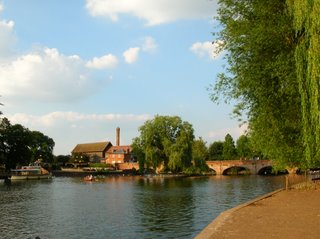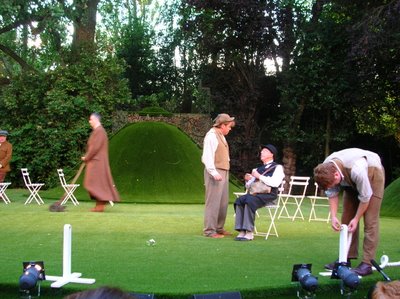
Stratford-upon-Avon
Watched: A Midsummer Night’s Dream live at the open air theatre in London. Fantastic!! One of the best productions of live theatre I’ve ever seen, anywhere. Last summer’s R & J at BreadLoaf was probably the best, but one can’t compare such startlingly different (though inter-related) plays.
Read: bits of books about performances of Dream.
All right, I broke my promise and didn’t post on the postivie aspects of material criticism yeterday. But half an hour before the bus left, I decided to go to London & see the play! So that’s my excuse. I also saw some wonderful Art, but more on that another time.
Material Texts
Now, to return. Rather than seeing cultural of texts as an ugly or disturbing truth, let’s look at it as a fascinating study of ways to interpret the plays and deepen our understanding of them. Knowing how a certain prop, costume, gesture, or word was received is itself an interpretive tool. Below are a few examples, most of which are due to Tiffany Stern, either from her excellent book Making Shakespeare or from her great lecture here at Lincoln college on Tuesday evening. We have established that the text we hold & read may or may not be Shakespeare’s. But it’s somebody’s, and it’s fantastic, whoever wrote it or collaborated on it. So let’s talk about some cultural features which would enhance our understanding of a play.
1. Actors’ parts/cues
In Elizabethan times, and indeed for a long time, maybe even up until the 18th century, actors did not get to see a copy of the whole play. Instead, they got just their own lines, with cues. I’m giving you a longish example so you can really see how it would work. Here’s something like what the Romeo actor would have gotten for the beginning of the scene at the ball:
___________________________years ago.
What lady’s that which doth enrich the hand
Of yonder knight?
__________________________________sir.
O, she doth teach the torches to burn bright!
It seems she hangs upon the cheek of night
As a rich jewel in an Ethiop’s ear,
Beauty too rich for use, for earth too dear.
Looking at a play in parts can be an interpretive device. It makes an actor’s character very plain. His emotions, tricks of speech, style, and vocab are on display. There are places in the plays where a character repeats his cue line—which means the other actor would interrupt him. There are places the cue-lines themselves become jokes, such as in Pyramus & Thisbe. Take a look at this:
Bottom: Cursed be thy stones for thus deceiving me.One of many jokes here is that ‘deceiving me’ would be the cue in the imaginary script for P & T, but the real cue for the actor-playing-Flute-playing-Thisbe is ‘Yonder she comes.’ One of many meta-theatre jokes.
Theseus: The wall methinks, being sensible, should curse again.
Bottom: No, in truth, sir, he should not. ‘Deceiving me’ is Thisbe’s cue…. It will fall pat as I told you. Yonder she comes.
Another result of part-scripts is that the actors are able to respond in more “natural” ways, because they really do not know what the other character will be saying! They really do not know who will deliver their cues, so they are listening as you do listen to a conversation, and I assume that they would adjust their responses based on what they hear, just as you do when you are formulating a reply during dialogue.
2. The playhouse. The physical location itself could lend meaning. The ceiling of the stage was painted to look like a sky, with stars/sun/moon/etc., and was called the “Heaven” or “heavens.” The area beneath the stage, from which ghosts and witches can emerge, was the “Hell.” These areas had obvious significance. Thus, when the ghost of Hamlet’s father emerges from the “hell,” the audience would know it was no “spirit of health,” but a “goblin damn’d”! So they were wiser than Hamlet, and than we. Here’s a photo of the restored Globe theatre in London:

3. Passions/gestures. Reading the plays in parts points up the emotional content of each role. Indeed, an actor’s skill in early modern times was largely calculated by how suddenly he swung from one passion to another: such as Leontes’s startling, shocking leap into jealously in the begining of The Winter’s Tale. So an actor preparing his part would look for clues, such as a shift from poetry into prose or vice versa, a change in vocabulary, a breakdown of syntax, lots of inappropriate repetition, etc., that could indicate a swift shift of emotion. Then he would choose actions and gestures to make these as explicit as possible on stage. Certain postrures and movements had clear significance. Lying on the floor, for example, meant deafeat or surrender. A woman’s hair, let down from its customary up-do, meant madness or wild distraction.
Perhaps now you can see a little of how studying the stuff surrounding the plays can be very informative, interesting, and fun. From another prrspective, looking at the material and cultural factors surrounding the [divinely inspired] human authors of the Bible can inform and deepen a reader’s understanding. Here’s a good website on the Bible & culture.
I will only give a few examples of how “Material Scripture” can be a helpful interpretive/applicative device.
1. Geography. Knowing the lay of the land is very, very useful for understanding the Old Testament especially. This might be analgous to the “playhouse” above. For example, the scholars and scientists searching for the lost city of Ai (see Joshua chap. 8) did both a topological survey of the potential location and a close reading of the text, and have come to realize that there were two ambush forces in the battle for Ai. The director of that dig, Bryant Wood, has also done stunning work on Jericho. For a long time, scholars didn’t think that the battle for Jericho and the walls falling down really happened the way the Bible says it does. Dr. Wood found beautiful proof it did: slanting piles of mud-brick wall, a piece left standing (where Rahab’s house was), etc.
2. Culture. Just a quick example. You know the verse where it says to give your enemy a cup of cold water, thus heaping burning coals on his head? That sounds like an awfully OT thing to do—getting revenge back-handedly. But in NT times, people had to keep their fires burning, and if their fire went out, they’d go to the neighbor and “borrow some fire.” They’d carry the hot coals home in a pan on their heads, feeling the lovely warmth around them in the cold winter morning. So, if your enemy wrongs you, give him comfort, give him the means of life! Knowing cultural tid-bits like this compares to knowing how an Elizabethan audience would understand gestures and popular phrases.
3. Creationist science. Or Young-Earth Creationism, or Intelligent Design, or whatever they’re calling it now-a-days. Studying something seemingly unrelated to exegesis—geology, the fossil record, astronomy, biology, population studies—sheds light on passages of Scripture. This is like knowing about the Ptolemaic universe in order to better understand Hamlet’s “brave / o'erhanging firmament, this majestical roof fretted / with golden fire.” I don’t have too much to say, but the principle should be clear. Take a look at this site for lots of facts.
That’s it! I’d love to see any other examples anybody might have, or feel free to argue with these ideas if you list.

A Midsummer Night’s Dream. The guy with the lawn mower is Bottom.
3 comments:
Here's the direct link for Associates for Biblical Research, the archeological group that did work on Ai and Jericho:
ABR
Here's the rest of Romeo's part for the Ball Scene, in case you're curious:
__________________________years ago.
What lady’s that which doth enrich the hand
Of yonder knight?
__________________________sir.
O, she doth teach the torches to burn bright!
It seems she hangs upon the cheek of night
As a rich jewel in an Ethiop’s ear,
Beauty too rich for use, for earth too dear.
So shows a snowy dove trooping with crows,
As yonder lady o'er her fellows shows.
The measure done, I'll watch her place of stand,
And, touching hers, make blessed my rude hand.
Did my heart love till now? forswear it, sight!
For I ne'er saw true beauty till this night.
__________________________ bitter gall.
If I profane with my unworthiest hand
This holy shrine, the gentle fine is this:
My lips, two blushing pilgrims, ready stand
To smooth that rough touch with a tender kiss.
__________________________palmers' kiss.
Have not saints lips, and holy palmers too?
__________________________in prayer.
O, then, dear saint, let lips do what hands do;
They pray, grant thou, lest faith turn to despair.
__________________________prayers' sake.
Then move not, while my prayer's effect I take.
Thus from my lips, by yours, my sin is purged.
__________________________have took.
Sin from thy lips? O trespass sweetly urged!
Give me my sin again.
__________________________by the book.
__________________________with you.
What is her mother?
__________________________the chinks.
Is she a Capulet?
O dear account! my life is my foe's debt.
__________________________the best.
Ay, so I fear; the more is my unrest.
This has very little to do with the topic, but I had to share it. Christopher Ricks, the great scholar of poetry, came and spoke here on Wednesday evening. He had a lot to say about the editorial process, which I should perhaps recall and post--maybe. But his most memorable saying was this:
There are four things you must do every day.
1. Pray
2. Floss your teeth
3. Back everything up
4. Consult the OED.
No day is complete without performing these activities.
Great advice!
Post a Comment